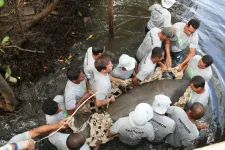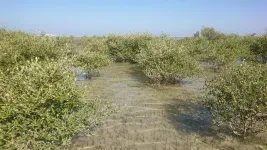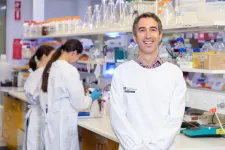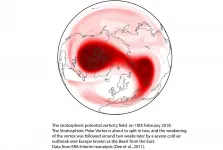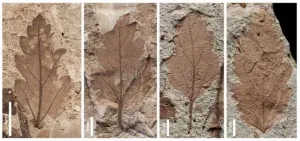Bone fracture risk may increase when critical enzymatic processes decline
Researchers examine key protein for clues about bone health
2021-01-05
(Press-News.org) TROY, N.Y. -- A loss of enzymatic processes within the body can increase a person's risk of bone fracture. This new insight was recently published in eLife by an international team of scientists and engineers led by Deepak Vashishth, the director of the Center for Biotechnology and Interdisciplinary Studies (CBIS) at Rensselaer Polytechnic Institute.
Enzymatic processes are essential to any number of chemical reactions that occur within the body, including the production of the extracellular matrix within bone that is critical for mechanical support. Phosphorylation -- one of those key enzymatic processes -- is the attachment of a phosphoryl to a protein, and is critical for cellular regulation. This process plays a role in many diseases, but until now, researchers didn't know if it altered tissue integrity and organ function.
In this paper, researchers looked at a protein known as osteopontin, which plays a vital role in holding the matrix together. The researchers developed a process by which they could induce phosphorylation -- or its counterpart, dephosphorylation -- in bones from genetically modified mice, some that had osteopontin and others that did not. By comparing results from the two groups, researchers found that fracture toughness, a measure of bone's mechanical strength, increased with osteopontin phosphorylation and declined with dephosphorylation. More specifically, phosphorylation enhanced crosslinks and increased the attraction between the charged groups on osteopontin and bone mineral, making bone stronger and its fracture more difficult.
"This is the first study that lays down that phosphorylation in bone matters, particularly how it assists bone in releasing energy, and that loss of this modification is bad for bone," Vashishth said.
The team also studied the effect of osteopontin phosphorylation levels in the rare bone diseases hypophosphatemia and hyperphosphatemia, which are associated with skeletal deformities. In both diseases, Vashishth said, osteopontin phosphorylation levels decreased, a finding that lays the groundwork for further exploration.
"Another promising discovery was that these levels do change with diseases in bone," Vashishth said. "Is phosphorylation directly affecting the fracture propensity of bones in these diseased conditions? And what therapeutic tools can we use to fix this? These are the questions that we want to investigate."
In the spirit of the New Polytechnic, the model that drives research and education at Rensselaer, this research was highly collaborative across multiple disciplines. Vashishth and his lab worked with researchers at McGill University in Canada, the University of Southampton in the United Kingdom, the University of Patras in Greece, Aarhus University in Denmark, and Vienna University of Technology in Austria. Each research team brought a different expertise and piece of this puzzle to the work.
The team's findings may also be applied to similar processes within other connective tissues and possible therapeutics to counteract abnormal osteopontin phosphorylation levels.
"This is not just specific to bone, because phosphorylation is a more ubiquitous change in other tissues in the body," Vashishth said. "Osteopontin is not only in bone, it's in other tissues in our body, like our kidneys and several other places. This research can also shed light on other things that can happen throughout the body."
INFORMATION:
About Rensselaer Polytechnic Institute
Founded in 1824, Rensselaer Polytechnic Institute is America's first technological research university. Rensselaer encompasses five schools, 32 research centers, more than 145 academic programs, and a dynamic community made up of more than 7,600 students and over 100,000 living alumni. Rensselaer faculty and alumni include more than 145 National Academy members, six members of the National Inventors Hall of Fame, six National Medal of Technology winners, five National Medal of Science winners, and a Nobel Prize winner in Physics. With nearly 200 years of experience advancing scientific and technological knowledge, Rensselaer remains focused on addressing global challenges with a spirit of ingenuity and collaboration. To learn more, please visit http://www.rpi.edu.
ELSE PRESS RELEASES FROM THIS DATE:
2021-01-05
Worldwide, marine megafauna are at risk of extinction due to climate change, habitat loss, pollution, overhunting, population fragmentation, and hybridization with related species in areas disturbed by humans. Genetic studies can help determine the conservation status of marine animals, identifying threats to species conservation and informing interventions and policies, such as the protection of diversity hotspots or corridors for gene flow.
In a new study in Frontiers in Marine Science, researchers for the first time measured genetic diversity in manatees ...
2021-01-05
CHAMPAIGN, Ill. -- A small portion of scientific papers are retracted for research that is in error or fraudulent. But those papers can continue to be cited by other scientists in their work, potentially passing along the misinformation from the retracted articles.
Jodi Schneider, a professor of information sciences at the University of Illinois Urbana-Champaign who studies scholarly publications and how information gets used, is considering how scientific journals can better communicate about retracted articles. In a new study published in the ...
2021-01-05
Most of the mangrove forests on the coasts of Oman disappeared about 6,000 years ago. Until now, the reason for this was not entirely clear. A current study of the University of Bonn (Germany) now sheds light on this: It indicates that the collapse of coastal ecosystems was caused by climatic changes. In contrast, falling sea level or overuse by humans are not likely to be the reasons. The speed of the mangrove extinction was dramatic: Many of the stocks were irreversibly lost within a few decades. The results are published in the journal Quaternary Research.
Mangroves are trees that occupy a very special ecological niche: They grow in the so-called tidal range, meaning coastal areas that are ...
2021-01-05
ALBUQUERQUE, N.M. -- If everything moved 40,000 times faster, you could eat a fresh tomato three minutes after planting a seed. You could fly from New York to L.A. in half a second. And you'd have waited in line at airport security for that flight for 30 milliseconds.
Thanks to machine learning, designing materials for new, advanced technologies could accelerate that much.
A research team at Sandia National Laboratories has successfully used machine learning -- computer algorithms that improve themselves by learning patterns in data -- to complete cumbersome materials science calculations more than 40,000 times faster than normal.
Their results, published Jan. 4 in END ...
2021-01-05
Australian research has identified a new mechanism in which prostate cancer cells can 'switch' character and become resistant to therapy.
These findings, just published in Cell Reports, are an important development in unravelling how an aggressive subtype of prostate cancer, neuroendocrine prostate cancer (NEPC), develops after hormonal therapies.
It is well established that some tumours show increased cellular 'plasticity' in response to new or stressful conditions, such as cancer therapy, says lead researcher Associate Professor Luke Selth, from the Flinders ...
2021-01-05
What The Study Did: Data from public health surveillance of reported COVID-19 cases and seroprevalence surveys were used in this observational study that reports an estimated 46.9 million SARS-CoV-2 infections, 28.1 million symptomatic infections, 956,174 hospitalizations and 304,915 deaths occurred in the U.S. through November 15, 2020.
Authors: Frederick J. Angulo, D.V.M., Ph.D., of Medical Development and Scientific/Clinical Affairs of Pfizer Vaccines, is the corresponding author.
To access the embargoed study: Visit our For The Media website at this link https://media.jamanetwork.com/
(doi:10.1001/jamanetworkopen.2020.33706)
Editor's ...
2021-01-05
A new study led by researchers at the Universities of Bristol, Exeter, and Bath helps to shed light on the winter weather we may soon have in store following a dramatic meteorological event currently unfolding high above the North Pole.
Weather forecasting models are predicting with increasing confidence that a sudden stratospheric warming (SSW) event will take place today, 5 January 2021.
The stratosphere is the layer of the atmosphere from around 10-50km above the earth's surface. SSW events are some of the most extreme of atmospheric phenomena and can see polar stratospheric temperature increase by up to 50°C over the course of a few days. Such events ...
2021-01-05
By André Julião | Agência FAPESP - The black lion tamarin (Leontopithecus chrysopygus) once inhabited most forest areas in the state of São Paulo, Southeast Brazil, but currently occupies only some Atlantic Rainforest remnants there. In recent years, after various studies of the endangered species, environmental NGO Instituto de Pesquisas Ecológicas (IPÊ) moved groups of these animals to areas from which the species had disappeared.
Similar initiatives have now been reinforced by a group of researchers at IPÊ, São Paulo State University (UNESP) and the Federal University of Mato Grosso (UFMT), who cross-tabulated climate data and data on landscape (forest cover) to determine the sites best suited for future ...
2021-01-05
The asteroid impact 66 million years ago that ushered in a mass extinction and ended the dinosaurs also killed off many of the plants that they relied on for food. Fossil leaf assemblages from Patagonia, Argentina, suggest that vegetation in South America suffered great losses but rebounded quickly, according to an international team of researchers.
"Every mass extinction event is like a reset button, and what happens after that reset depends on which organisms survive and how they shape the biosphere," said Elena Stiles, a doctoral student at the University of Washington who completed the research as part of her master's thesis at Penn State. "All the biodiversity ...
2021-01-05
PROVIDENCE, R.I. [Brown University] -- Last month, Japan's Hayabusa2 mission brought home a cache of rocks collected from a near-Earth asteroid called Ryugu. While analysis of those returned samples is just getting underway, researchers are using data from the spacecraft's other instruments to reveal new details about the asteroid's past.
In a study published in Nature Astronomy, researchers offer an explanation for why Ryugu isn't quite as rich in water-bearing minerals as some other asteroids. The study suggests that the ancient parent body from which Ryugu was formed had likely dried out in some kind of heating event before Ryugu came into being, which left Ryugu itself drier than expected.
"One of the ...
LAST 30 PRESS RELEASES:
[Press-News.org] Bone fracture risk may increase when critical enzymatic processes decline
Researchers examine key protein for clues about bone health
